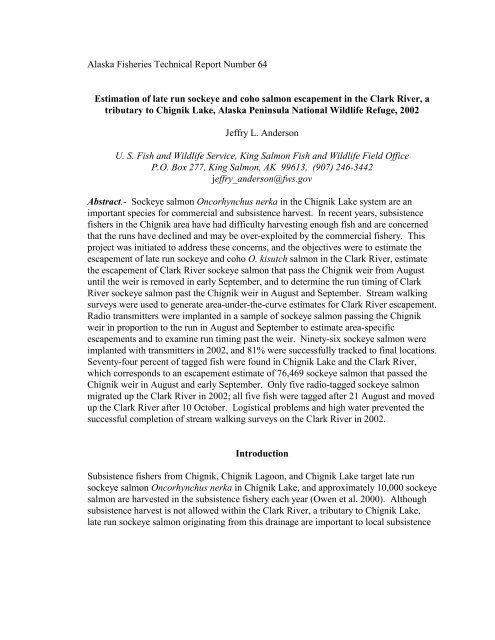Estimation of late run sockeye and coho salmon escapement in the ...
Estimation of late run sockeye and coho salmon escapement in the ...
Estimation of late run sockeye and coho salmon escapement in the ...
Create successful ePaper yourself
Turn your PDF publications into a flip-book with our unique Google optimized e-Paper software.
Alaska Fisheries Technical Report Number 64<br />
<strong>Estimation</strong> <strong>of</strong> <strong>late</strong> <strong>run</strong> <strong>sockeye</strong> <strong>and</strong> <strong>coho</strong> <strong>salmon</strong> <strong>escapement</strong> <strong>in</strong> <strong>the</strong> Clark River, a<br />
tributary to Chignik Lake, Alaska Pen<strong>in</strong>sula National Wildlife Refuge, 2002<br />
Jeffry L. Anderson<br />
U. S. Fish <strong>and</strong> Wildlife Service, K<strong>in</strong>g Salmon Fish <strong>and</strong> Wildlife Field Office<br />
P.O. Box 277, K<strong>in</strong>g Salmon, AK 99613, (907) 246-3442<br />
jeffry_<strong>and</strong>erson@fws.gov<br />
Abstract.- Sockeye <strong>salmon</strong> Oncorhynchus nerka <strong>in</strong> <strong>the</strong> Chignik Lake system are an<br />
important species for commercial <strong>and</strong> subsistence harvest. In recent years, subsistence<br />
fishers <strong>in</strong> <strong>the</strong> Chignik area have had difficulty harvest<strong>in</strong>g enough fish <strong>and</strong> are concerned<br />
that <strong>the</strong> <strong>run</strong>s have decl<strong>in</strong>ed <strong>and</strong> may be over-exploited by <strong>the</strong> commercial fishery. This<br />
project was <strong>in</strong>itiated to address <strong>the</strong>se concerns, <strong>and</strong> <strong>the</strong> objectives were to estimate <strong>the</strong><br />
<strong>escapement</strong> <strong>of</strong> <strong>late</strong> <strong>run</strong> <strong>sockeye</strong> <strong>and</strong> <strong>coho</strong> O. kisutch <strong>salmon</strong> <strong>in</strong> <strong>the</strong> Clark River, estimate<br />
<strong>the</strong> <strong>escapement</strong> <strong>of</strong> Clark River <strong>sockeye</strong> <strong>salmon</strong> that pass <strong>the</strong> Chignik weir from August<br />
until <strong>the</strong> weir is removed <strong>in</strong> early September, <strong>and</strong> to determ<strong>in</strong>e <strong>the</strong> <strong>run</strong> tim<strong>in</strong>g <strong>of</strong> Clark<br />
River <strong>sockeye</strong> <strong>salmon</strong> past <strong>the</strong> Chignik weir <strong>in</strong> August <strong>and</strong> September. Stream walk<strong>in</strong>g<br />
surveys were used to generate area-under-<strong>the</strong>-curve estimates for Clark River <strong>escapement</strong>.<br />
Radio transmitters were implanted <strong>in</strong> a sample <strong>of</strong> <strong>sockeye</strong> <strong>salmon</strong> pass<strong>in</strong>g <strong>the</strong> Chignik<br />
weir <strong>in</strong> proportion to <strong>the</strong> <strong>run</strong> <strong>in</strong> August <strong>and</strong> September to estimate area-specific<br />
<strong>escapement</strong>s <strong>and</strong> to exam<strong>in</strong>e <strong>run</strong> tim<strong>in</strong>g past <strong>the</strong> weir. N<strong>in</strong>ety-six <strong>sockeye</strong> <strong>salmon</strong> were<br />
implanted with transmitters <strong>in</strong> 2002, <strong>and</strong> 81% were successfully tracked to f<strong>in</strong>al locations.<br />
Seventy-four percent <strong>of</strong> tagged fish were found <strong>in</strong> Chignik Lake <strong>and</strong> <strong>the</strong> Clark River,<br />
which corresponds to an <strong>escapement</strong> estimate <strong>of</strong> 76,469 <strong>sockeye</strong> <strong>salmon</strong> that passed <strong>the</strong><br />
Chignik weir <strong>in</strong> August <strong>and</strong> early September. Only five radio-tagged <strong>sockeye</strong> <strong>salmon</strong><br />
migrated up <strong>the</strong> Clark River <strong>in</strong> 2002; all five fish were tagged after 21 August <strong>and</strong> moved<br />
up <strong>the</strong> Clark River after 10 October. Logistical problems <strong>and</strong> high water prevented <strong>the</strong><br />
successful completion <strong>of</strong> stream walk<strong>in</strong>g surveys on <strong>the</strong> Clark River <strong>in</strong> 2002.<br />
Introduction<br />
Subsistence fishers from Chignik, Chignik Lagoon, <strong>and</strong> Chignik Lake target <strong>late</strong> <strong>run</strong><br />
<strong>sockeye</strong> <strong>salmon</strong> Oncorhynchus nerka <strong>in</strong> Chignik Lake, <strong>and</strong> approximately 10,000 <strong>sockeye</strong><br />
<strong>salmon</strong> are harvested <strong>in</strong> <strong>the</strong> subsistence fishery each year (Owen et al. 2000). Although<br />
subsistence harvest is not allowed with<strong>in</strong> <strong>the</strong> Clark River, a tributary to Chignik Lake,<br />
<strong>late</strong> <strong>run</strong> <strong>sockeye</strong> <strong>salmon</strong> orig<strong>in</strong>at<strong>in</strong>g from this dra<strong>in</strong>age are important to local subsistence
















